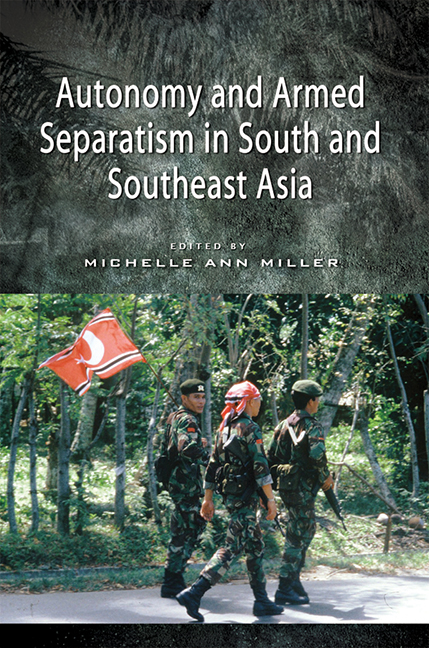Book contents
- Frontmatter
- Dedication
- Contents
- Acknowledgements
- About the Contributors
- 1 The Problem of Armed Separatism: Is Autonomy the Answer?
- 2 Mediated Constitutionality as a Solution to Separatism
- 3 Self-Governance as a Framework for Conflict Resolution in Aceh
- 4 Autonomy and Armed Separatism in Papua: Why the Cendrawasih Continues to Fear the Garuda
- 5 The Parallels and the Paradox of Timor-Leste and Western Sahara
- 6 Between Violence and Negotiation: Rethinking the Indonesian Occupation and the East Timorese Resistance
- 7 Struggle over Space in Myanmar: Expanding State Territoriality after the Kachin Ceasefire
- 8 Sri Lanka's Ethnic Conflict: The Autonomy-Separation Dialectic
- 9 Unitarianism, Separatism and Federalism: Competing Goals and Problems of Compromise in Sri Lanka
- 10 Autonomy and Armed Separatism in Jammu and Kashmir
- 11 Armed Conflicts and Movements for Autonomy in India's Northeast
- 12 Southern Thailand: The Trouble with Autonomy
- 13 The Last Holdout of an Integrated State: A Century of Resistance to State Penetration in Southern Thailand
- 14 Interlocking Autonomy: Manila and Muslim Mindanao
- 15 History, Demography and Factionalism: Obstacles to Conflict Resolution through Autonomy in the Southern Philippines
- 16 Conclusion
- Index
13 - The Last Holdout of an Integrated State: A Century of Resistance to State Penetration in Southern Thailand
Published online by Cambridge University Press: 21 October 2015
- Frontmatter
- Dedication
- Contents
- Acknowledgements
- About the Contributors
- 1 The Problem of Armed Separatism: Is Autonomy the Answer?
- 2 Mediated Constitutionality as a Solution to Separatism
- 3 Self-Governance as a Framework for Conflict Resolution in Aceh
- 4 Autonomy and Armed Separatism in Papua: Why the Cendrawasih Continues to Fear the Garuda
- 5 The Parallels and the Paradox of Timor-Leste and Western Sahara
- 6 Between Violence and Negotiation: Rethinking the Indonesian Occupation and the East Timorese Resistance
- 7 Struggle over Space in Myanmar: Expanding State Territoriality after the Kachin Ceasefire
- 8 Sri Lanka's Ethnic Conflict: The Autonomy-Separation Dialectic
- 9 Unitarianism, Separatism and Federalism: Competing Goals and Problems of Compromise in Sri Lanka
- 10 Autonomy and Armed Separatism in Jammu and Kashmir
- 11 Armed Conflicts and Movements for Autonomy in India's Northeast
- 12 Southern Thailand: The Trouble with Autonomy
- 13 The Last Holdout of an Integrated State: A Century of Resistance to State Penetration in Southern Thailand
- 14 Interlocking Autonomy: Manila and Muslim Mindanao
- 15 History, Demography and Factionalism: Obstacles to Conflict Resolution through Autonomy in the Southern Philippines
- 16 Conclusion
- Index
Summary
Similar to other countries in Southeast Asia, Thailand has been affected by internal conflicts for much of the post-colonial era. The resurgence of violence in southern Thailand is the latest episode of an ongoing centre-periphery conflict that has its roots in the consolidation of the Thai state beginning in the early twentieth century. Contrary to the Philippines and Indonesia, however, Thailand has never seriously considered decentralization of state authority as a response to insurgent grievances. While other countries in South and Southeast Asia have recently experimented with autonomy arrangements as response to long-running separatist conflicts, the concept of autonomy has long been anathema to the Thai body politic.
There have, however, been periods of relaxed centralization, increased restraint by Thailand's security forces, and the expansion of political space for conflict-affected minority populations that have been instrumental in fostering a détente between the state and separatist insurgents, leading to significant periods of calm. In most cases, actually, Thailand's minority populations have been peacefully integrated into the nation-state, especially in regions where the extension of the state happened gradually, with limited intrusion into local communities. In the Thai context, the critical policy dialogue on the causes and responses to insurgency does not consider autonomy per se, but rather the degree to which centralization of authority is applied over time and the level of state coercion used to enforce this authority.
This chapter will analyze the historical ebb and flow of centralization and coercion by the Thai state in conflict-affected peripheral regions. In particular, why have some ethnic minorities been peacefully integrated into the state, while others have resisted state control for decades? We will use a simple model, designed for this analysis, to compare different state approaches for consolidating control in minority regions and corresponding patterns of resistance to state authority. The model will be used to compare the history of centre-periphery relations in Satun province (located at the western end of the border with Malaysia) and the northeastern region (usually referred to as Isaan), as a contrast to the conflict-affected southern border provinces of Pattani, Yala and Narathiwat.
- Type
- Chapter
- Information
- Autonomy and Armed Separatism in South and Southeast Asia , pp. 235 - 255Publisher: ISEAS–Yusof Ishak InstitutePrint publication year: 2012



